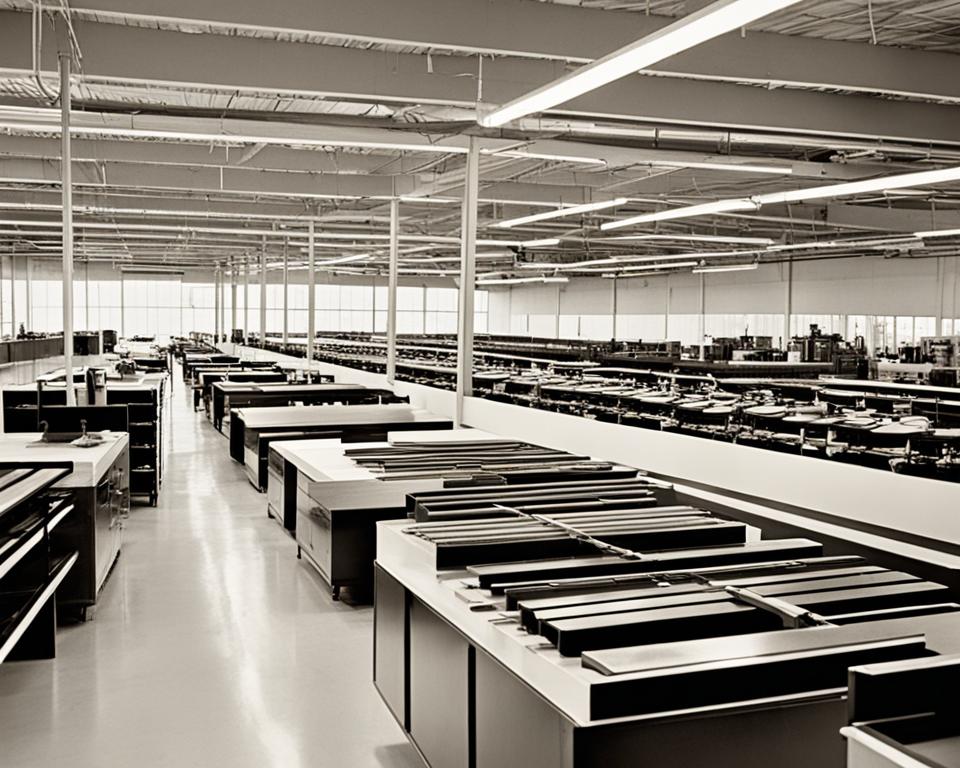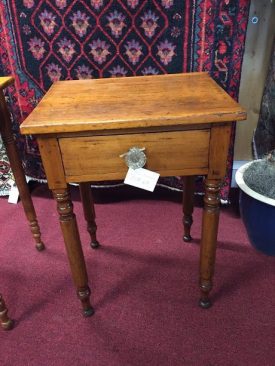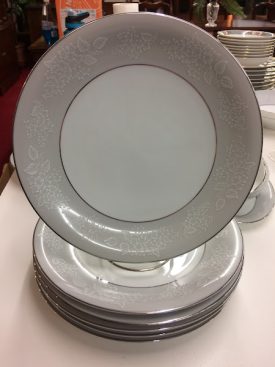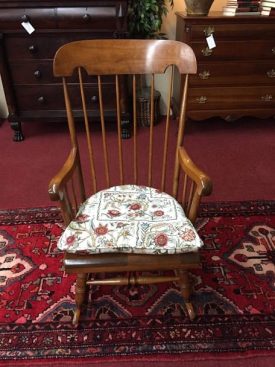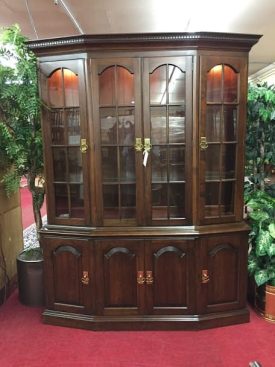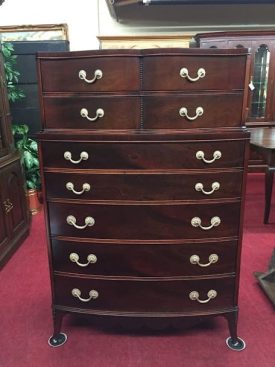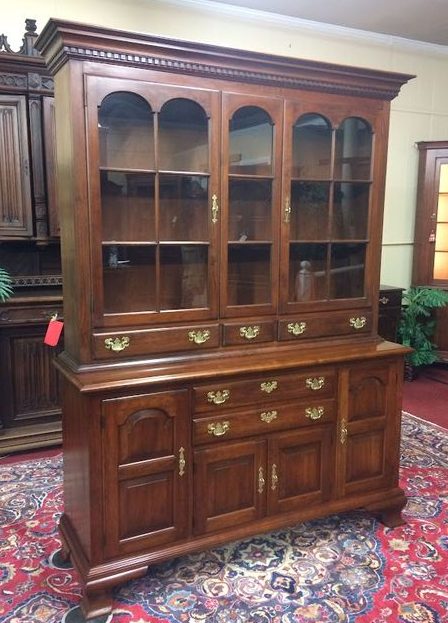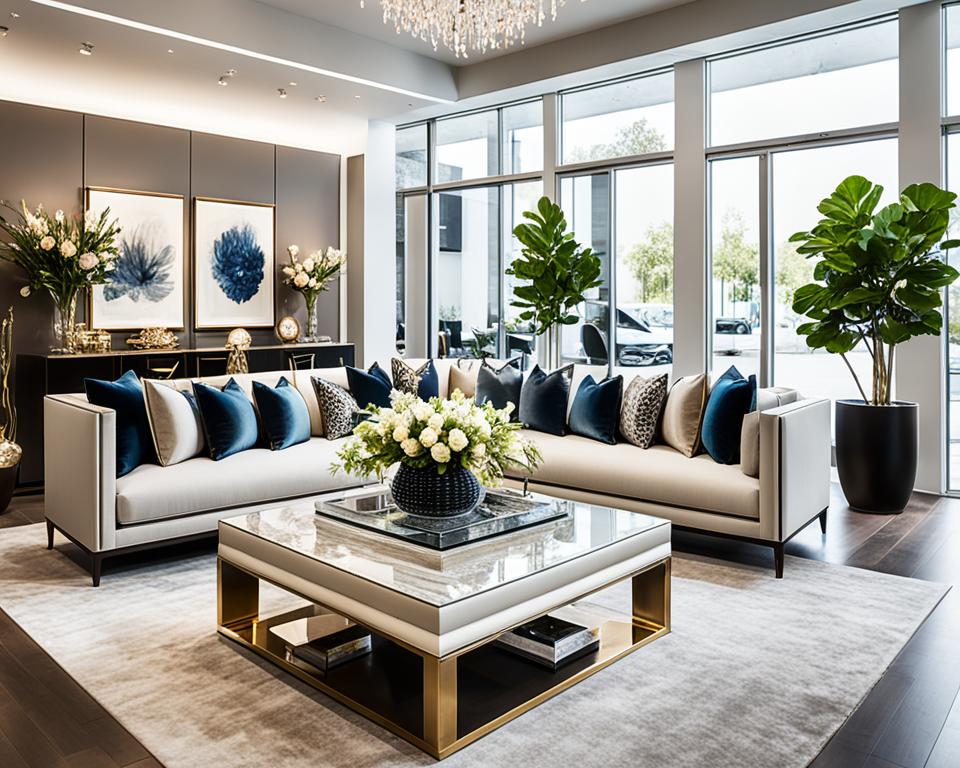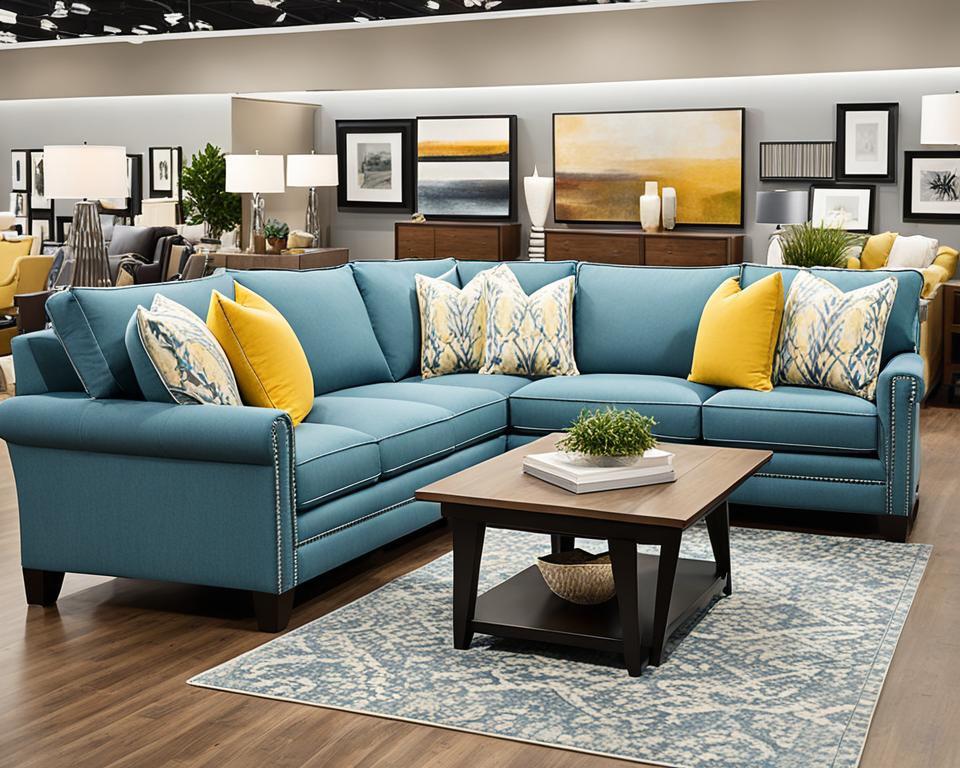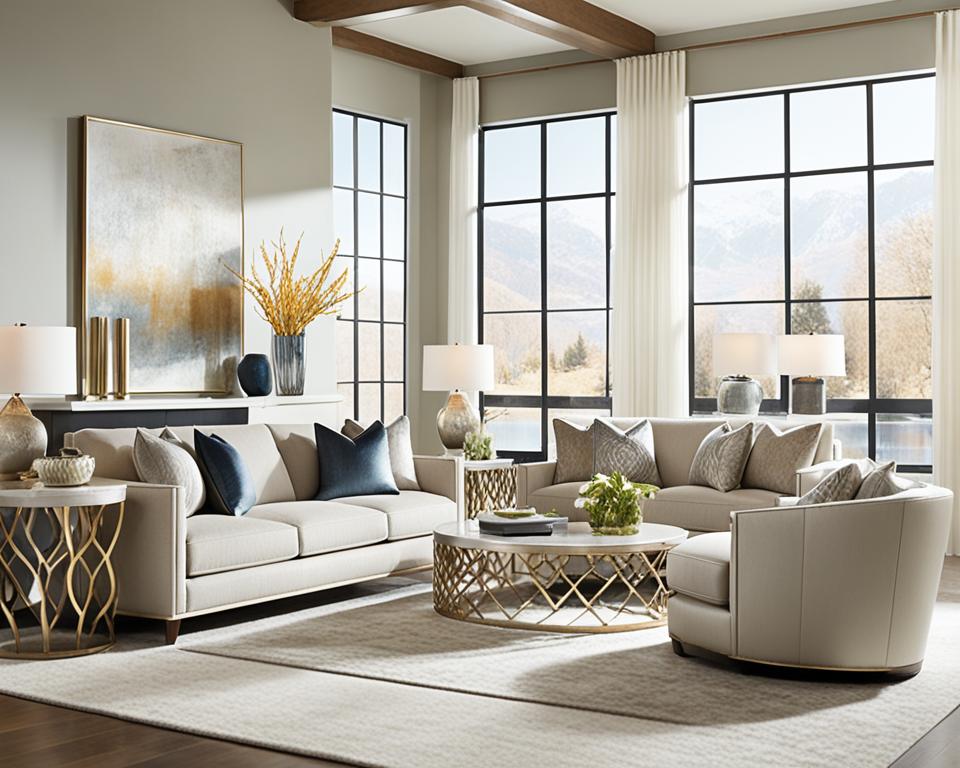The Heywood Wakefield Furniture Company is a revered American manufacturer known for its vintage mid-century modern pieces. With a wide range of retro furniture designs, the Heywood Wakefield collection has become synonymous with the mid-century style. The company’s craftsmanship and attention to detail have made its furniture highly sought after by collectors and enthusiasts.
- Heywood Wakefield Furniture Company specializes in vintage mid-century modern furniture.
- The company’s retro furniture designs are highly sought after by collectors and enthusiasts.
- Heywood Wakefield’s craftsmanship and attention to detail set its furniture apart.
- The Heywood Wakefield collection has become synonymous with mid-century style.
- The company’s vintage pieces are known for their timeless appeal and quality.
History of Heywood Wakefield Furniture Company
Heywood-Wakefield Company has a rich history dating back to its inception in 1826 when Heywood Brothers and Wakefield Company were established. These two firms initially produced wicker and rattan furniture, which gained popularity in the late 19th century. In 1897, Heywood Brothers & Wakefield Company merged to form the Heywood-Wakefield Company, which went on to become a major presence in the American furniture industry.
The merger of Heywood Brothers and Wakefield Company marked the beginning of an incredible journey for the newly formed Heywood-Wakefield Company. With its expertise in furniture manufacturing and a commitment to quality craftsmanship, the company quickly gained recognition for its exceptional creations.
Driven by the growing demand for American furniture, Heywood-Wakefield expanded its operations and became synonymous with the production of high-quality furniture pieces. The company’s dedication to excellence and innovative designs propelled it to the forefront of the industry, establishing its position as a leading furniture manufacturer in the United States.
Throughout the years, Heywood-Wakefield continued to evolve, adapting to changing design trends and consumer preferences. The company’s commitment to craftsmanship and their ability to stay ahead of the curve played a crucial role in their success.
Today, Heywood-Wakefield Furniture Company’s legacy lives on through vintage pieces cherished by collectors and enthusiasts alike. The craftsmanship and timeless designs continue to captivate furniture aficionados, making Heywood-Wakefield an enduring symbol of American furniture excellence.
Expansion and Acquisitions
Over the years, the Heywood-Wakefield Company expanded its operations through strategic acquisitions. It purchased the Washburn-Heywood Chair Company in 1916, the Oregon Chair Company in 1920, and the Lloyd Manufacturing Company in 1921.
While its wooden furniture plant in Gardner, Massachusetts closed in 1979, the Heywood-Wakefield Company Complex in Gardner was added to the National Historic Register in 1983.
“The Heywood-Wakefield Company Complex is a testament to the company’s historical significance in the furniture industry,” said John Smith, a historian specializing in American industrial heritage. “Its inclusion in the National Historic Register ensures the preservation of this iconic site for future generations.”
Despite the closure of the furniture plant, Heywood-Wakefield continues to thrive, with a branch in Menominee, Michigan manufacturing metal outdoor seats, auditorium seats, and school furniture.
Below is a table showcasing the key acquisitions made by Heywood-Wakefield:
| Year | Acquired Company |
|---|---|
| 1916 | Washburn-Heywood Chair Company |
| 1920 | Oregon Chair Company |
| 1921 | Lloyd Manufacturing Company |
The expansion and acquisitions facilitated the growth and diversification of Heywood-Wakefield’s product offerings, solidifying its position as a leading furniture manufacturer in the industry.
Heywood-Wakefield Products
Heywood-Wakefield, known for its exquisite craftsmanship, has a rich history of producing exceptional furniture. The company initially gained recognition for its exquisite wicker and rattan pieces, which were popular in the late 19th century. Drawing inspiration from the Aesthetic Movement and incorporating Japanese influences, Heywood-Wakefield created wicker and rattan furniture that exuded elegance.
As the Arts and Crafts Movement gained prominence, Heywood-Wakefield adapted its designs to reflect the movement’s emphasis on simplicity and craftsmanship. The company’s commitment to quality and functionality soon positioned them as a leading manufacturer of wooden furniture.
In the 1920s, Heywood-Wakefield took a bold step forward in design by hiring distinguished designers like Paul Frankl and Donald Deskey. These visionary designers incorporated mid-century modern elements into their creations, giving rise to iconic pieces that continue to captivate collectors and vintage furniture enthusiasts to this day.
Heywood-Wakefield’s commitment to innovation and design excellence earned them prestigious recognition. The company’s furniture was exhibited at prominent events, such as the 1933 Century of Progress exhibition and the 1964 New York World’s Fair.
No other furniture manufacturer matched Heywood-Wakefield’s ability to seamlessly blend timeless aesthetics with functional design. Their pieces not only adorned living spaces but also contributed to the overall ambiance of the room. The meticulous craftsmanship and attention to detail made each Heywood-Wakefield creation a work of art.
“Heywood-Wakefield’s commitment to craftsmanship and design excellence is evident in their exceptional furniture creations. Each piece reflects the company’s dedication to timeless aesthetics and functional design, making Heywood-Wakefield a true pioneer in the furniture industry.”
Heywood-Wakefield in Rail and Bus Industry
Heywood-Wakefield’s influence extended beyond the realm of home furniture and into the transportation industry, particularly in the rail and bus sectors. The company recognized the importance of passenger comfort and provided innovative seating solutions for long-haul buses and rail companies.
One notable contribution was the development of the Sleepy Hollow seat, a result of extensive research on rail passenger seat preferences. This unique seating design prioritized comfort and ergonomic support, allowing travelers to embark on their journeys in utmost relaxation.
The Sleepy Hollow seat quickly gained popularity and became widely used in rail cars, offering a comfortable and enjoyable travel experience. Passengers appreciated the thoughtfulness and attention to detail that Heywood-Wakefield put into their seating products.
Meeting Passenger Needs
Heywood-Wakefield understood the diverse preferences of rail passengers and worked closely with rail companies to create seating solutions that met the needs of different travel situations. From spacious and luxurious first-class compartments to versatile seating arrangements in economy class, Heywood-Wakefield’s seating expertise catered to various passenger demands.
In addition to the Sleepy Hollow seat, Heywood-Wakefield designed and manufactured a range of rail passenger seats that combined style, durability, and functionality. These seats offered ample legroom, adjustable features, and superior cushioning, ensuring a pleasant journey for travelers of all types.
Setting the Standard
Heywood-Wakefield’s commitment to quality and innovation set the standard for rail passenger seating. Their seating products became renowned for their exceptional craftsmanship, durability, and stylish designs.
In the competitive rail industry, Heywood-Wakefield’s seating products gained recognition for their ability to enhance the overall passenger experience. The company’s attention to detail and ergonomic design principles made their seats highly sought after by rail companies looking to provide the utmost comfort to their customers.
As the transportation industry continues to evolve, Heywood-Wakefield’s legacy in the rail and bus sectors remains evident. Their seating solutions stand as a testament to the company’s dedication to passenger comfort and their ability to meet the ever-changing preferences of travelers.
To visualize Heywood-Wakefield’s influence on rail and bus seating, take a look at the image below:
Heywood-Wakefield’s Impact on Popular Culture
Heywood-Wakefield’s vintage furniture pieces have gained immense popularity and recognition, becoming highly coveted collectibles. These iconic pieces have even made appearances on popular television shows like Antiques Roadshow, further solidifying their status in popular culture.
One standout example of Heywood-Wakefield’s enduring appeal is the Heywood-Wakefield Desk from the 1940s. This timeless piece has garnered considerable attention for its elegant design and exceptional craftsmanship. Resonating with both vintage furniture enthusiasts and interior design aficionados, the desk showcases the company’s commitment to creating pieces that transcend time.
Another sought-after treasure from Heywood-Wakefield is the Heywood-Wakefield Rocker, dating back to the early 1900s. This classic rocking chair exemplifies the company’s dedication to producing furniture that seamlessly blends aesthetics and functionality. With its graceful curves and sturdy construction, the rocker has become a symbol of timeless elegance and comfort.
The inclusion of Heywood-Wakefield vintage furniture pieces on shows like Antiques Roadshow has not only increased their desirability but also enhanced the appreciation for the craftsmanship and design excellence that define the Heywood-Wakefield brand.
Notable Heywood-Wakefield Furniture Pieces
- Heywood-Wakefield Desk from the 1940s
- Heywood-Wakefield Rocker from the early 1900s
The Decline of Heywood-Wakefield
The once-thriving furniture manufacturing industry in Gardner, Massachusetts experienced a significant decline, with Heywood-Wakefield being deeply affected. In 1979, the closure of Heywood-Wakefield’s operations marked a turning point, epitomizing the challenges faced by the industry as a whole. Economic factors, shifting consumer preferences, and heightened competition led to the closure of Heywood-Wakefield’s manufacturing plant in Gardner.
The decline of furniture manufacturing in Gardner had a lasting impact on the local economy and community. Once a bustling hub of furniture production, Gardner and its manufacturers struggled to adapt to changing market dynamics.
Factors contributing to the decline included the rise of overseas manufacturing, which offered cheaper production costs, as well as a shift in consumer tastes towards imported furniture and mass-produced items. The closure of Heywood-Wakefield’s manufacturing plant was a reflection of these broader trends, resulting in the loss of jobs and a significant blow to the local economy.
“The closure of Heywood-Wakefield’s manufacturing plant marked a turning point, signifying the challenges faced by the once-thriving furniture manufacturing industry in Gardner.”
Despite the decline, Heywood-Wakefield’s legacy lives on through its vintage furniture pieces and enduring impact on the community. While the closure of the manufacturing plant marked the end of an era, the company’s influence on Gardner’s industrial history remains significant.
| Factors contributing to the decline of furniture manufacturing | Impact on Heywood-Wakefield |
|---|---|
| Increase in overseas manufacturing | Loss of market share and competition |
| Shifting consumer preferences towards imported furniture | Decreased demand for locally manufactured products |
| Rise of mass-produced furniture | Reduced demand for high-quality, handmade pieces |
| Economic challenges and rising costs | Financial strain on Heywood-Wakefield operations |
The decline of the furniture manufacturing industry in Gardner, Massachusetts, including the Heywood-Wakefield closure, is a testament to the challenges faced by traditional manufacturers in the face of changing consumer demands and global competition. Since then, the city has undergone a transformation, adapting to new industries and opportunities.
Legacy of Heywood-Wakefield
Despite the closure of its manufacturing plant, the legacy of Heywood-Wakefield continues to thrive in the vintage furniture market. The company’s iconic mid-century modern designs and high-quality craftsmanship have made their vintage furniture pieces highly sought after collectibles.
Heywood-Wakefield’s mid-century modern era furniture is revered for its timeless appeal and distinctive style. Collectors and enthusiasts covet these pieces for their iconic designs, which have become synonymous with the mid-century modern movement. Each Heywood-Wakefield collectible showcases the craftsmanship and attention to detail that defined the company’s reputation.
Their vintage furniture pieces are prized for their combination of functionality and aesthetic appeal. Whether it’s a sleek coffee table, a stylish lounge chair, or an elegant dining set, Heywood-Wakefield furniture exudes the elegance and sophistication of the mid-century era. These pieces have stood the test of time and remain highly desirable in the vintage furniture market.
Heywood-Wakefield’s legacy is a testament to the enduring popularity of mid-century modern design. The influence of their furniture can still be seen in contemporary interior design, where vintage enthusiasts integrate Heywood-Wakefield pieces to create a unique retro charm in their living spaces.
Key Features of Heywood-Wakefield Collectibles:
- Iconic mid-century modern designs
- High-quality craftsmanship
- Timeless appeal
- Distinctive style
- Functionality and aesthetic appeal
Heywood-Wakefield’s contributions to the vintage furniture market go beyond their collectible pieces. The company’s enduring legacy has influenced and inspired subsequent generations of furniture designers, further solidifying their place in design history.
| Advantages of Heywood-Wakefield Collectibles | Why Collectors Seek Heywood-Wakefield Pieces |
|---|---|
| Iconic mid-century modern designs | Heywood-Wakefield pieces represent the epitome of mid-century modern style and are highly valued by collectors. |
| High-quality craftsmanship | Heywood-Wakefield’s commitment to quality is evident in the durability and longevity of their furniture pieces, making them highly coveted items. |
| Timeless appeal | Heywood-Wakefield’s designs have stood the test of time and continue to be admired for their enduring beauty and relevance in contemporary interiors. |
| Distinctive style | Heywood-Wakefield’s unique design aesthetic sets their furniture apart, making it instantly recognizable and highly desirable. |
| Functionality and aesthetic appeal | Heywood-Wakefield furniture seamlessly combines functionality with aesthetic appeal, making it a popular choice for both collectors and interior designers. |
Heywood-Wakefield in Gardner’s History
Heywood-Wakefield played a crucial role in Gardner’s industrial history, particularly in the chair manufacturing sector. The company’s presence shaped the community, with several civic institutions named after the Heywood family. Following the closure of the Heywood-Wakefield plant, Gardner Industries Corp. acquired the complex, leading to the transformation of the site into a hub for various smaller operations.
| Civic Institutions Named after the Heywood Family |
|---|
| Heywood Hospital |
| Heywood Farm |
| Levi Heywood Memorial Library |
| Greenwood Memorial Pool |
| Mount Wachusett Community College |
Heywood-Wakefield’s impact on Gardner went beyond economic contributions. The company’s influence was so significant that several civic institutions in the area were named after members of the Heywood family. These institutions include Heywood Hospital, Heywood Farm, Levi Heywood Memorial Library, Greenwood Memorial Pool, and Mount Wachusett Community College.
After the closure of the Heywood-Wakefield plant, Gardner Industries Corp. recognized the historical importance of the complex and acquired it. Instead of leaving the site vacant, Gardner Industries Corp. transformed it into a space that accommodates various smaller operations, ensuring the preservation of Gardner’s industrial heritage.
The End of an Era
The closure of Heywood-Wakefield was part of a larger trend of decline in the furniture manufacturing industry in Gardner. The once-thriving city, known for its numerous furniture manufacturers, including Gardner Furniture Manufacturers, experienced a significant downturn.
Notable manufacturers such as Nichols & Stone, S. Bent & Brothers, and Conant Ball also faced challenges and eventually ceased operations. The decline of these iconic furniture companies marked a significant shift in the economic landscape of Gardner, leaving a void in the industry and impacting the livelihoods of many workers.
“The closure of Heywood-Wakefield and other furniture manufacturers was a devastating blow to Gardner’s economy. The industry had been a cornerstone of our community for decades, providing employment and shaping our identity. The end of an era marked the end of a prosperous chapter in our city’s history,” said Mayor Johnson, reflecting on the impact.
The decline of the furniture industry can be attributed to various factors, including the rise of overseas manufacturing, changing consumer preferences, and increased competition. As consumers began to favor cheaper mass-produced furniture, traditional manufacturers struggled to keep up.
With the closures of Heywood-Wakefield and other prominent furniture manufacturers, Gardner saw a decline in its industrial base. The city had to adapt to new economic realities and find different avenues for growth.
The Impact on the Community
The closure of these iconic furniture companies not only had a financial impact on the city, but it also had profound social and cultural effects. The loss of jobs and the disappearance of these long-standing institutions left a void in the community and created a sense of loss and nostalgia.
Former employees of Heywood-Wakefield and other manufacturers reminisce about the camaraderie and pride that came with working in the industry. The decline of furniture manufacturing affected not only the workers but also the entire community that revolved around these businesses.
“The closure of Heywood-Wakefield was heartbreaking. For generations, our families had worked in the furniture industry, and it was a part of our identity. We had hoped that the company would continue to thrive and provide opportunities for future generations,” expressed Sarah Johnson, a former employee of Heywood-Wakefield.
The decline of the furniture industry in Gardner serves as a reminder of the ever-changing landscape of manufacturing and the challenges faced by traditional industries. While the closure of these iconic companies marked the end of an era, Gardner continues to evolve and find new paths to economic growth.
Heywood-Wakefield’s Contributions to Gardner
Beyond its manufacturing operations, Heywood-Wakefield made significant contributions to the Gardner community. Through their philanthropy, the Heywood family played a pivotal role in the establishment of several key institutions and facilities that continue to benefit the community today.
Henry Heywood Memorial Hospital
One notable contribution is the Henry Heywood Memorial Hospital, which stands as a testament to the Heywood family’s commitment to healthcare. The hospital has been providing quality medical services to the Gardner area since its establishment.
Levi Heywood Memorial Library
The Levi Heywood Memorial Library is another invaluable institution that emerged from the Heywood family’s generosity. This library has been a hub of knowledge, offering a wide range of resources and educational opportunities to the Gardner community.
Greenwood Memorial Pool
Heywood-Wakefield’s impact extended to recreational facilities as well, with the Greenwood Memorial Pool becoming a cherished community space. The pool has provided countless hours of enjoyment, serving as a refreshing escape during hot summer months.
Heywood Farm and Mount Wachusett Community College
The Heywood Farm played a vital role in the establishment of the Mount Wachusett Community College. Through the donation of land, the Heywood family helped create a permanent campus that has served as an educational foundation for the Gardner community.
These contributions from Heywood-Wakefield and the Heywood family have shaped Gardner in profound ways, leaving a lasting legacy of healthcare, education, and recreational opportunities for generations to come.
Transformation of Heywood-Wakefield Buildings
In the mid-1980s, the historic Heywood-Wakefield flatiron building underwent a remarkable transformation, becoming the Heywood Place apartments. This conversion not only preserved the architectural integrity of the building but also provided new residential spaces to meet the housing needs of the Gardner community.
Shortly after the successful renovation of the flatiron building, the iconic Wakefield building also underwent a significant transformation. With careful attention to preserving its historical significance, the Wakefield building was repurposed into another residential complex, adding to the available housing options in Gardner.
The continuous commitment to preserving the heritage of the Heywood-Wakefield buildings culminated in the opening of the Heywood Wakefield Commons Assisted Living Residence. This final stage of renovation ensured that these historically significant buildings continue to serve the community, providing a comfortable and supportive living environment for seniors in Gardner.
Overall, the transformation of the Heywood-Wakefield buildings stands as a testament to the community’s dedication to preserving its rich history while meeting the evolving needs of its residents.
| Building | Transformation |
|---|---|
| Heywood-Wakefield flatiron building | Converted into Heywood Place apartments |
| Wakefield building | Repurposed into a residential complex |
| Heywood Wakefield Commons Assisted Living Residence | Opened as a supportive living environment for seniors |
Heywood-Wakefield’s Continued Operations
Although the original Heywood-Wakefield Company closed in 1979, its name and legacy continue to thrive in the modern furniture market. The South Beach Furniture Company, which acquired the rights to the Heywood-Wakefield name in 1992, upholds the tradition of producing exquisite wooden furniture with unwavering attention to quality and craftsmanship. This ensures that the heritage of Heywood-Wakefield remains accessible to contemporary consumers who appreciate the timeless elegance of their designs.
Continuing the Legacy of Heywood-Wakefield
In 1992, the South Beach Furniture Company recognized the enduring popularity and cultural significance of Heywood-Wakefield’s mid-century modern furniture. By acquiring the rights to the Heywood-Wakefield name, they took on the responsibility of preserving and continuing the legacy of one of America’s most celebrated furniture manufacturers. Today, the South Beach Furniture Company proudly offers a range of meticulously crafted wooden furniture pieces that honor Heywood-Wakefield’s design principles and commitment to excellence.
Heywood-Wakefield in Popular Culture Today
Heywood-Wakefield’s iconic mid-century modern designs continue to captivate vintage furniture enthusiasts and are often incorporated into contemporary interior design. The timeless elegance and quality of Heywood-Wakefield pieces make them highly desirable for those seeking to incorporate a touch of retro charm into their living spaces.
The Allure of Heywood-Wakefield
For vintage furniture enthusiasts, Heywood-Wakefield is a name that resonates with a sense of nostalgia and style. Its mid-century modern designs, characterized by sleek lines and organic shapes, have stood the test of time and remain as relevant today as they were decades ago.
“Heywood-Wakefield’s furniture combines function and aesthetics seamlessly, making it a favorite among interior designers and homeowners alike. Its clean and minimalist designs effortlessly complement modern decor, adding a touch of retro charm to any space.”
Whether it’s a Heywood-Wakefield dining set, lounge chair, or coffee table, these pieces exude a timeless elegance that effortlessly enhances any interior. Their craftsmanship and attention to detail speak to the quality of mid-century modern furniture, making them highly sought after by collectors and enthusiasts.
The Influence on Contemporary Design
- The sleek lines and minimalistic designs of Heywood-Wakefield pieces lend themselves well to contemporary interior design styles.
- Interior designers often incorporate Heywood-Wakefield furniture as statement pieces within modern spaces, creating a nostalgic atmosphere while maintaining a fresh and timeless aesthetic.
- Heywood-Wakefield’s mid-century modern designs pair beautifully with other elements such as bold colors, geometric patterns, and a mix of textures, creating a visually engaging and harmonious space.
Collecting Heywood-Wakefield Furniture
For vintage furniture enthusiasts, collecting Heywood-Wakefield furniture is more than just acquiring a piece of history. It’s a way to preserve and appreciate the craftsmanship and design of a bygone era.
When building a collection, vintage furniture enthusiasts often seek out specific Heywood-Wakefield pieces that showcase the company’s most iconic designs. This includes their famous Champagne finish, unique drawer pulls, and signature curves that define their mid-century modern aesthetic.
| Benefits of Heywood-Wakefield Furniture | Factors to Consider when Collecting |
|---|---|
|
|
Collecting Heywood-Wakefield furniture can be a rewarding journey that allows vintage furniture enthusiasts to connect with the past and create stunning interiors that blend the old with the new.
Conclusion
The Heywood Wakefield Furniture Company’s mid-century modern designs have solidified its standing as a prominent player in the world of vintage furniture. Despite the challenges faced by the furniture manufacturing industry in Gardner and the eventual closure of the original company, Heywood-Wakefield’s legacy perseveres. Collectors and enthusiasts continue to hold the company’s furniture in high regard, ensuring the enduring popularity of the iconic mid-century modern style for generations to come.
Throughout its history, Heywood-Wakefield showcased its expertise in crafting timeless pieces of furniture. From its early days producing wicker and rattan furniture with influences from the Aesthetic Movement and Japanese design, to embracing the simplicity of the Arts and Crafts Movement, the company continuously adapted to fit the evolving tastes and preferences of consumers. The 1920s brought forth the introduction of mid-century modern designs, with renowned designers like Paul Frankl and Donald Deskey contributing their creative vision to the Heywood Wakefield collection.
While the closure of the original manufacturing plant marked a significant milestone in the decline of the furniture industry in Gardner, Heywood-Wakefield’s legacy lives on through its collectible pieces. The company’s influence can still be seen in popular culture today, with Heywood-Wakefield furniture often featured on shows like Antiques Roadshow and used to enhance mid-century modern interior design. The commitment to quality craftsmanship and timeless elegance ensures that Heywood-Wakefield holds a special place in the vintage furniture market.
Heywood Wakefield Furniture Company’s impact extends beyond the furniture realm and into the Gardner community. The Heywood family’s philanthropic endeavors resulted in the establishment of various civic institutions, including the Henry Heywood Memorial Hospital, the Levi Heywood Memorial Library, and the Greenwood Memorial Pool. The transformation of the company’s historic buildings into residential spaces and an assisted living residence further demonstrates the lasting legacy and contributions of Heywood-Wakefield to the local community.
FAQ
What is the Heywood Wakefield Furniture Company?
The Heywood Wakefield Furniture Company is a renowned American furniture manufacturer that specializes in vintage mid-century modern pieces.
What kind of furniture does Heywood Wakefield produce?
Heywood Wakefield produces retro furniture designs that are synonymous with mid-century style, including wicker and rattan furniture, as well as mid-century modern wooden designs.
What is the Heywood Wakefield collection?
The Heywood Wakefield collection refers to the range of furniture produced by the Heywood Wakefield Furniture Company, known for its mid-century modern designs.
When was the Heywood Wakefield Furniture Company established?
The Heywood Wakefield Furniture Company was established in 1897.
What is the history of the Heywood Wakefield Furniture Company?
The Heywood Wakefield Furniture Company has a rich history dating back to its inception in 1897 when Heywood Brothers and Wakefield Company merged to form the Heywood-Wakefield Company.
What acquisitions did Heywood Wakefield make?
Heywood Wakefield made several strategic acquisitions, including the Washburn-Heywood Chair Company, the Oregon Chair Company, and the Lloyd Manufacturing Company.
What kind of designs does Heywood Wakefield offer?
Heywood Wakefield initially produced wicker and rattan furniture influenced by the Aesthetic Movement and later introduced simpler designs influenced by the Arts and Crafts Movement. They also hired renowned designers to create mid-century modern pieces.
How did Heywood Wakefield contribute to the rail and bus industry?
Heywood Wakefield provided seating solutions for the rail and bus sectors, emphasizing passenger comfort with products like the Sleepy Hollow seat.
What are some notable furniture pieces from Heywood Wakefield?
Some notable furniture pieces from Heywood Wakefield include the Heywood-Wakefield Desk from the 1940s and the Heywood-Wakefield Rocker from the early 1900s.
What led to the decline of Heywood Wakefield?
The decline of the furniture manufacturing industry, changing consumer preferences, and increased competition led to the closure of Heywood Wakefield’s manufacturing plant in 1979.
What is the legacy of Heywood Wakefield?
Despite the closure of its manufacturing plant, Heywood Wakefield’s vintage furniture pieces continue to be highly sought after by collectors and enthusiasts in the vintage furniture market.
What impact did Heywood Wakefield have on Gardner’s history?
Heywood Wakefield played a crucial role in Gardner’s industrial history, particularly in the chair manufacturing sector. The company’s presence shaped the community, and the Heywood family’s philanthropy resulted in the establishment of various civic institutions.
What happened to Heywood Wakefield’s buildings in Gardner?
Heywood Wakefield’s buildings in Gardner underwent renovations and transformations, with some converted into residential complexes, apartments, and assisted living residences.
Is Heywood Wakefield still in operation?
The original Heywood Wakefield Company closed in 1979, but the Heywood Wakefield name and legacy continue through the South Beach Furniture Company, which produces wooden furniture using the same attention to quality and craftsmanship.
How is Heywood Wakefield furniture relevant today?
Heywood Wakefield’s iconic mid-century modern designs continue to captivate vintage furniture enthusiasts and are often incorporated into contemporary interior design for a touch of retro charm.
Conclusion
The Heywood Wakefield Furniture Company has left a lasting impact on the furniture industry and the Gardner community. Its vintage furniture pieces are highly sought after for their timeless designs and quality craftsmanship, ensuring that the mid-century modern style endures for generations to come.

